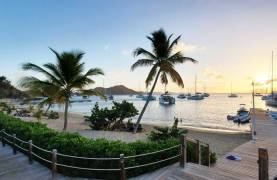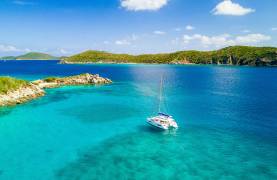
So, you want to spend some time on a sailing yacht but don’t know where to start? Welcome to our guide to everything you need to know to embark on a sailing adventure.
Where should I go?
Have a look at our destinations pages to pick your perfect sailing ground from our 25 bases in:
We’ve split our destinations into levels, so you can choose your vacation based on your skill and comfort level. These levels act as a guide to our sailing areas, encompassing tides, wind, weather conditions and navigational challenges that you may encounter.
Which is the right yacht for me?
Now you know which part of the world you want to sail in, you need to decide which yacht to choose.
Monohull

When most people talk about a sailing a yacht, they have the traditional monohull in mind. The classic yacht, they are designed to slice through the water, offering thrilling sailing, but less space than a catamaran. Monohulls have keels that sit much deeper in the water, and so they have to be acutely aware of water depths. These yachts are best for couples, small groups, flotillas, and people after a more dynamic sailing experience.
Catamaran

Spread across two hulls, catamarans offera much larger and more spacious living environment, and sit higher on the water, meaning they can explore much shallower areas. They may surrender some upwind performance to the monohulls, but they are a go-anywhere exploring yacht, perfect for large groups.
Yacht vital statistics
You may often see certain values attached to a yacht specification; here’s what they are and why they’re important:
- LOA = Length overall, the length of the hull at the longest point, handy to know so you’re sure you can fit into a marina, and used as a measure for charging berthing fees.
- LWL = Load Waterline length – The length of the hull in contact with the water. The longer your LWL, the more sail area your yacht can carry without increasing beam or draft, and the faster it can go.
- Beam = Width of the yacht, an important factor in the ratio for stability and living space.
- Draft = How far down, including the keel, the yacht goes. Absolutely essential knowledge when mooring, assessing tides and navigating hazards.
- Displacement = The volume of water displaced by the yacht is used to determine its weight in the water, knowledge of which helps to create a stable, yet nimble yacht.
- Sail Area = given in feet or meters squared, this is the maximum amount of sail that can catch the wind and power the yacht.
Types of sailing vacations
Bareboat charter

A bareboat charter puts you in control, as you literally charter the bareboat, without a skipper or crew. Perfect for experienced sailors looking to take the helm and discover true freedom at sea, independently sailing your own yacht. Jump on board our first-class fleet in 25 superb destinations. You will require qualification and/or certain level of sailing experience to bareboat charter a yacht.
Flotilla vacations

Sail in the company of other yachts, guided by an expert Sunsail lead crew, who will organize your itinerary. Join a Flotilla in the Caribbean or Mediterranean. You will require some experience to join a flotilla without a skipper.
Skippered vacations

Experience sailing in the expert hands of a Sunsail Skipper. Skippered charters are available at every Sunsail base, and are ideal for the inexperienced. These are great for beginners or those looking to improve under the skipper’s watchful eye.
Sailing schools

New to sailing? Start your sailing journey or take your next step with Sunsail and earn an RYA qualification. We have sailing schools in Portsmouth, The British Virgin Islands, Phuket, Lefkas, Marina Agana, and the Whitsundays.
Other things to account for
Qualifications
There is a growing trend for charter companies and local authorities to make sailing qualifications a pre-requisite to booking a charter.
Sailors don’t necessarily need licenses in many places outside the wider Mediterranean (Greece, Croatia, Turkey, Spain, Italy), but you will need a degree of suitable experience with a similar size yacht in order to charter without a skipper.
If you can’t sail at all or don’t have the required qualifications, then you can hire a skipper, take a sailing school course at home or abroad to earn an accredited Royal Yachting Association (RYA) qualification, or combine the best of both worlds with our specialist Flotilla Hero and Flotilla Starter courses.
Yacht Damage Waiver
Yachts are costly assets and repairing damage on them can be expensive. All charter companies operate a damage waiver scheme.
In a nutshell, you pay a small, non-refundable premium before you charter so that you’re liable for a lot less if damage occurs. These schemes are almost always optional, so if you’d rather pocket a couple of hundred quid you can, but be prepared to be liable for a much larger outlay in the event of damage.
Fuel
When you pick your yacht up it will be full of fuel, but before you book you’ll be offered the option of pre-paying for a whole tank or filling it up and paying locally for just what you’ve used.
What more do you need?
Now you know pretty much everything you need to begin planning your charter. What are you waiting for?
To find out more, or book your next great adventure, call us on 888 350 3568.
Contributor
Ian Pedersen
Step Aboard Here
Start your experience with Sunsail on land and sign up to receive e-mails from us about yachts, offers and destinations.
By clicking 'Sign up' you confirm that you have read and understood our Privacy Policy and consent to our use of your information.



